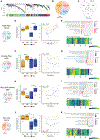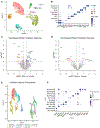The transcriptome of playfulness is sex biased in the juvenile rat medial amygdala: A role for inhibitory neurons
- PMID: 40478737
- PMCID: PMC12255958
- DOI: 10.1016/j.celrep.2025.115782
The transcriptome of playfulness is sex biased in the juvenile rat medial amygdala: A role for inhibitory neurons
Abstract
Social play is a well-conserved, dynamic behavior known to be sexually differentiated. In most species, males play more than females, a sex difference largely driven by the medial amygdala (MeA), yet the full mechanism establishing this bias is unknown. Here, we explore "the transcriptome of playfulness" in both sexes, demonstrating that the transcriptomic profile in the juvenile rat MeA associated with playfulness is markedly distinct in males and females. Parallel single-cell RNA sequencing experiments from newborn rats suggest that inhibitory neurons drive this sex difference. Furthermore, we show that inhibitory neurons comprise the majority of play-active cells in the juvenile MeA, with males having more play-active cells than females, of which a greater proportion are GABAergic. Through integrative bioinformatic analyses, we further explore the expression, function, and cell-type specificity of key play-associated gene modules, providing valuable insight into the sex-biased mechanisms underlying this fundamental social behavior.
Keywords: CP: Cell biology; CP: Neuroscience; RNAseq; WGCNA; amygdala; medial amygdala; scRNA-seq; sex differences; social behavior; social play.
Copyright © 2025 The Author(s). Published by Elsevier Inc. All rights reserved.
Conflict of interest statement
Declaration of interests The authors declare no competing interests.
Figures






Update of
-
The transcriptome of playfulness is sex-biased in the juvenile rat medial amygdala: a role for inhibitory neurons.bioRxiv [Preprint]. 2024 Sep 11:2024.09.11.612456. doi: 10.1101/2024.09.11.612456. bioRxiv. 2024. Update in: Cell Rep. 2025 Jun 24;44(6):115782. doi: 10.1016/j.celrep.2025.115782. PMID: 39314276 Free PMC article. Updated. Preprint.
Similar articles
-
The transcriptome of playfulness is sex-biased in the juvenile rat medial amygdala: a role for inhibitory neurons.bioRxiv [Preprint]. 2024 Sep 11:2024.09.11.612456. doi: 10.1101/2024.09.11.612456. bioRxiv. 2024. Update in: Cell Rep. 2025 Jun 24;44(6):115782. doi: 10.1016/j.celrep.2025.115782. PMID: 39314276 Free PMC article. Updated. Preprint.
-
Sex differences in the structure and function of the vasopressin system in the ventral pallidum are associated with the sex-specific regulation of social play behavior in juvenile rats.Horm Behav. 2024 Jul;163:105563. doi: 10.1016/j.yhbeh.2024.105563. Epub 2024 May 20. Horm Behav. 2024. PMID: 38772158 Free PMC article.
-
A cross-species analysis of neuroanatomical covariance sex differences in humans and mice.Biol Sex Differ. 2025 Jul 1;16(1):47. doi: 10.1186/s13293-025-00728-1. Biol Sex Differ. 2025. PMID: 40598550 Free PMC article.
-
Differently different?: A commentary on the emerging social cognitive neuroscience of female autism.Biol Sex Differ. 2024 Jun 13;15(1):49. doi: 10.1186/s13293-024-00621-3. Biol Sex Differ. 2024. PMID: 38872228 Free PMC article. Review.
-
Psychological interventions for adults who have sexually offended or are at risk of offending.Cochrane Database Syst Rev. 2012 Dec 12;12(12):CD007507. doi: 10.1002/14651858.CD007507.pub2. Cochrane Database Syst Rev. 2012. PMID: 23235646 Free PMC article.
References
-
- van den Berg CL, Hol T, Van Ree JM, Spruijt BM, Everts H, and Koolhaas JM (1999). Play is indispensable for an adequate development of coping with social challenges in the rat. Dev. Psychobiol 34, 129–138. - PubMed
MeSH terms
Grants and funding
LinkOut - more resources
Full Text Sources
Miscellaneous

